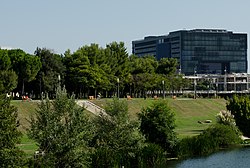
Back Montpellier Afrikaans Montpellier ALS ሞንፐልዬ Amharic Montpeller AN مونبلييه Arabic مونبيلييه ARZ Montpellier AST Montpellier AVK Monpelye Azerbaijani مونپلیه AZB
You can help expand this article with text translated from the corresponding article in French. (February 2024) Click [show] for important translation instructions.
|
Montpellier
Montpelhièr (Occitan) | |
|---|---|
Prefecture and commune | |
Clockwise from top: The Place de la Comédie, Port Marianne's lake, the bank of the Lez with the Hôtel de Ville, and the Cathedral of Saint Peter. | |
| Coordinates: 43°36′43″N 3°52′38″E / 43.6119°N 3.8772°E | |
| Country | France |
| Region | Occitania |
| Department | Hérault |
| Arrondissement | Montpellier |
| Canton | Montpellier-1, 2, 3, 4, 5 and Montpellier – Castelnau-le-Lez |
| Intercommunality | Montpellier Méditerranée Métropole |
| Government | |
| • Mayor (2020–2026) | Michaël Delafosse[1] |
Area 1 | 56.88 km2 (21.96 sq mi) |
| • Urban | 310.0 km2 (119.7 sq mi) |
| • Metro | 2,414 km2 (932 sq mi) |
| Population (2022)[2] | 307,101 |
| • Rank | 7th in France |
| • Density | 5,400/km2 (14,000/sq mi) |
| • Urban (Jan. 2020[3]) | 465,950 |
| • Urban density | 1,500/km2 (3,900/sq mi) |
| • Metro (Jan. 2020[4]) | 813,272 |
| • Metro density | 340/km2 (870/sq mi) |
| Demonym(s) | Montpelliérain (masculine) Montpelliéraine (feminine) |
| Time zone | UTC+01:00 (CET) |
| • Summer (DST) | UTC+02:00 (CEST) |
| INSEE/Postal code | 34172 /34000, 34070, 34080, 34090 |
| Elevation | 7–121 m (23–397 ft) (avg. 27 m or 89 ft) |
| 1 French Land Register data, which excludes lakes, ponds, glaciers > 1 km2 (0.386 sq mi or 247 acres) and river estuaries. | |
Montpellier (UK: /mɒntˈpɛlieɪ/; US: /ˌmoʊnpɛlˈjeɪ/; French: [mɔ̃pəlje, -pɛl-] ⓘ;[5][6] Occitan: Montpelhièr [mumpeˈʎɛ]) is a city in southern France near the Mediterranean Sea. One of the largest urban centres in the region of Occitania, Montpellier is the prefecture of the department of Hérault. At the 2020 census, 299,096 people lived in the city proper,[7] while its metropolitan area had a population of 813,272.[4] The inhabitants are called Montpelliérains.
In the Middle Ages, Montpellier was an important city of the Crown of Aragon (and was the birthplace of James I), and then of Majorca, before its sale to France in 1349. Established in 1220, the University of Montpellier is one of the oldest universities in the world and has the oldest medical school still in operation, with notable alumni such as Petrarch, Nostradamus and François Rabelais. Above the medieval city, the ancient citadel of Montpellier is a stronghold built in the seventeenth century by Louis XIII of France.
Since the 1990s, Montpellier has experienced one of the strongest economic and demographic growths in the country.[citation needed] Its urban area has experienced the highest population growth in France since the year 2000. Numbering 70,000, students comprise nearly one-fourth of its population, one of the highest such proportions in Europe.[8] Its living environment, with one of Europe's largest pedestrian areas,[9] along with its rich cultural life and Mediterranean climate, explains the enthusiasm for the city, which is nicknamed the "Gifted". Montpellier was nominated for "Best Emerging Culture City of the Year 2017" by the think tank LCD.[10] It is ranked as a Sufficiency city by the Globalization and World Cities Research Network.
- ^ "Répertoire national des élus: les maires" (in French). data.gouv.fr, Plateforme ouverte des données publiques françaises. 13 September 2022.
- ^ "Populations de référence 2022" (in French). The National Institute of Statistics and Economic Studies. 19 December 2024.
- ^ INSEE. "Statistiques locales - Montpellier : Unité urbaine 2020 - Population municipale 2020". Retrieved 2 March 2023.
- ^ a b INSEE. "Statistiques locales - Montpellier : Aire d'attraction des villes 2020 - Population municipale 2020". Retrieved 2 March 2023.
- ^ "CSA.fr - Êtes-vous [montpeulier], [montpélier] ou encore [montpéyé] ? / Langue française - Prononciation de certains noms de villes / Les dossiers d'actualité / Etudes et publications / Accueil". Archived from the original on 17 April 2017. Retrieved 2 June 2016.
- ^ Wells, John C. (2008). Longman Pronunciation Dictionary (3rd ed.). Longman. ISBN 978-1-4058-8118-0.
- ^ INSEE. "Statistiques locales - Montpellier : Commune 2022 - Population municipale 2020". Retrieved 2 March 2023.
- ^ "Montpellier Tourist Information and Montpellier Tourism". Montpellier Information and Tourism. Retrieved 5 June 2010.
- ^ "Itinerary of a walk in Montpellier". Travelers without borders. 25 October 2015. Retrieved 31 October 2020.
- ^ "Nomination de Montpellier aux "Leading Culture Destinations Awards 2017"". www.montpellier.fr (in French). Retrieved 31 October 2020.








